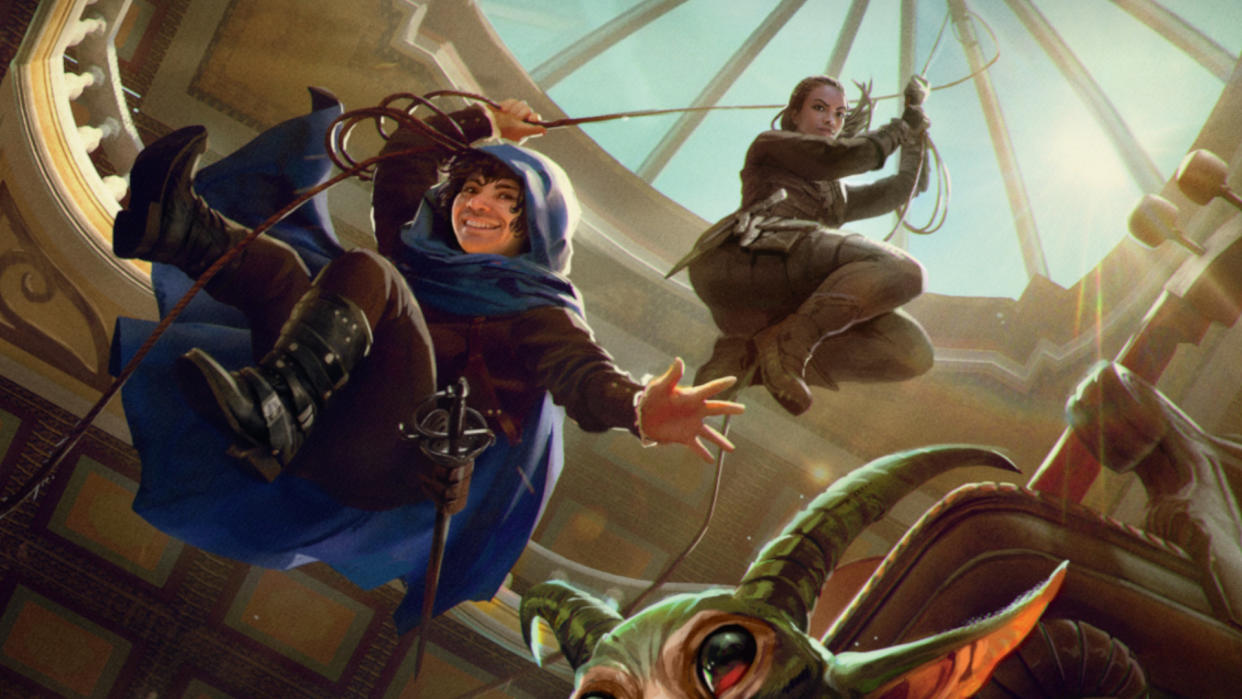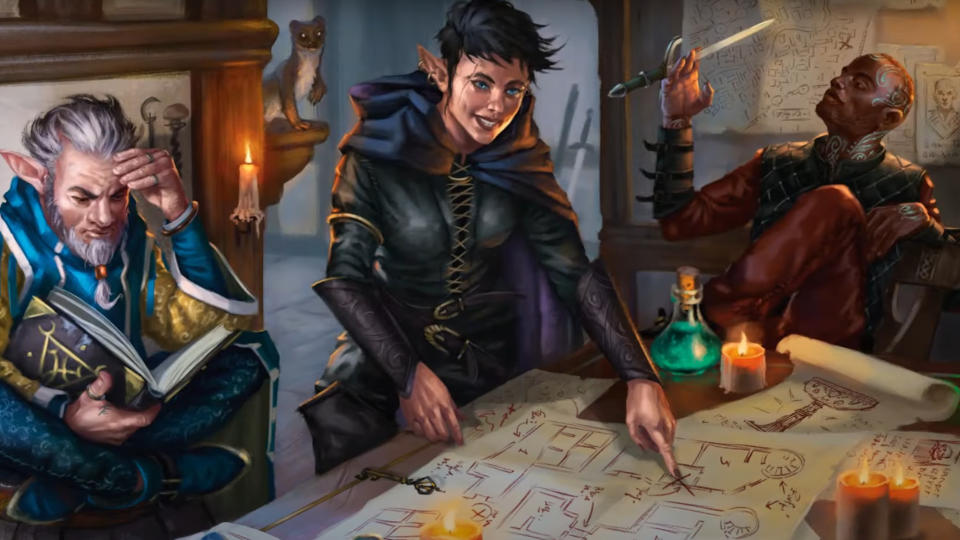Keys From the Golden Vault review: "Both daring and problematic"

Wizards of the Coast have published more long-term campaigns for fifth edition Dungeons & Dragons than the majority of groups could ever realistically hope to play. So it’s perhaps surprising that we haven’t seen more adventure anthologies for Dungeon Masters to drop into their own homebrew settings. The balance started to improve with Journeys Through the Radiant Citadel, and now we have another anthology to follow it up, Keys from the Golden Vault.
The unifying concept here is one of thievery: all the adventures are heists or break-ins of one kind or another. However, it underlines a problem with many Dungeons and Dragons books - the fact that the system is better suited to some stories than others.
Keys From the Golden Vault - features
Keys From the Golden Vault is a collection of heist-themed adventures that can be played as one-shots, a connected campaign, or added into your group's ongoing game. There are 13 stories in total that span levels 1 to 11, and most can be integrated with your own fantasy world (though a few take place within established settings like the Forgotten Realms).
How does Keys From the Golden Vault work?

Introduces a society of good-aligned thieves to use as a campaign hook
Encourages players away from combat-heavy classes
Contains tips on keeping heist adventures tense and exciting
Keys from the Golden Vault doesn’t feature much in the way of new rules. There are barely any new magical items or monsters for Dungeon Masters to fit into their wider designs. What it does offer is the titular Golden Vault, a mysterious company of benevolent rogues and outlaws who perform illegal activities when the application of the rules has not resulted in justice. You don’t have to use the Golden Vault if you don’t want to, but the book introduces them as a way to string all the adventures together into a very loose campaign should you so wish.
Keys From the Golden Vault is trying to do something both daring and problematic by subverting the foundations of Dungeons & Dragons
Aside from the occasional novel object or creature introduced as part of a plot, the only other wider addition is a section on how to run heist adventures. It includes advice like encouraging the party to plan and styling their chosen player characters away from the usual murder-hobo lineup toward something more subtle. There are also a number of ways in which the heist concept can be made more challenging on the fly by introducing unexpected complications in the manner of any number of noir-style developments.
Keys From the Golden Vault - gameplay

Players will need to scout out each heist location and invent a plan
Open-ended structure has lots of potential, but can be hard for the DM to handle
The D&D rules aren’t the best framework to support spying and subterfuge
Almost as soon as you open the book, you’ll realize that Keys From the Golden Vault is trying to do something both daring and problematic by subverting the foundations of Dungeons & Dragons. The game was based on, and has always been a close relative of, combat-heavy miniature wargames. Violence is a key focus of the rule set, with dozens of pages devoted to fighting and only a paragraph on how to use thieves' tools. By switching the focus to stealth and subterfuge, you’re asking the game to support a style of play it was never designed for. You can see this right away in the initial advice to get players to design characters accordingly.
In theory, given that all of the best tabletop RPGs are open frameworks for improvisation, this is a bold but plausible move. And the best of these scenarios get away with it. Take 'Shard of the Accursed', for example. It’s essentially a classic dungeon crawl with a heist-themed twist in which the players must break into a tomb to return a cursed item. This setup plays to the game’s strengths, offering a novel blend of skullduggery and exploration with a surprisingly emotional twist that allows role-players to shine.
What Shard of the Accursed, and all the other adventures here, bring to the table is a new way to enjoy Dungeons & Dragons. Rather than just storming in, wands blazing, players tackling these scenarios must scout the joint, follow up leads, and then make some kind of plan for pulling off the job. In addition to the expected maps and monsters, the adventures detail things like security measures, patrol timings, and possible disguises. As a result, they offer the players a lot of freedom and can unfold in very unexpected directions which can be fun, but is perhaps not ideal for inexperienced Dungeon Masters.
The book is frustratingly sketchy over what the Golden Vault actually is
Other standouts include 'Masterpiece Imbroglio' which pits the players against a rival heist team (it's a classic piece of revenge noir performed inside a Nine Hells-themed casino), and 'Affair on the Concordant Express', a mystery set aboard a flying train. However, imaginative as the latter two are, they flag up a wider issue with Keys from the Golden Vault. In trying to be as creative and unusual as possible, some of these adventures become difficult to drop into an existing campaign. If you haven’t trailed the concept of a massive infernal gambling den powered by magical geegaws it’s a hard thing to suddenly introduce.
This issue extends even to some of the weaker offerings like the initial scenario, 'The Murkmire Malevolence'. This requires your campaign to have a large museum, replete with academic staff, in which to set the caper. Even if you can find room in your quasi-medieval setting for this concept, you’ll still have to roleplay any number of museum guards or gala guests while juggling timing issues and discouraging combat-happy players from trying to slaughter everyone. And if this adventure goes wrong for the players it’s going to go very wrong indeed, and there’s limited material to help you resolve the mess.
You might imagine that you could use the organisation of the Golden Vault itself to try and put a bit of narrative structure around the wilder scenarios. But this is problematic. You still have to have a campaign world in which hellish casinos and flying trains are the norm. And the book is frustratingly sketchy over what the Golden Vault actually is, devoting less than two pages to the organization. Indeed, some of that is dedicated to an NPC contact for the players to deal with. It’s a very thin framework on which to hang a 13-adventure campaign.
Should you buy Keys From the Golden Vault?

And this is the fundamental problem with Keys from the Golden Vault: it’s very hard to see how a group is going to get good value for money from the book. The adventures vary in quality, but many are excellent and all are novel and a refreshing change of pace. But often they’re too wild and wacky to easily drop into an existing campaign.
Nonetheless, running the whole book as a campaign isn’t a better option. The concept of the Golden Vault itself is weak, you’ll still have to do the work to create a coherent narrative, and a whole campaign based on a concept Dungeons & Dragons isn’t built to handle is asking too much of the rules. They’re ideal material for one-shots, though, if your group is happy to put in the work to set that up; they're fast and fresh and fizzing with good ideas.
Buy it if...
Don't buy it if...
For more recommendations, don't miss the best board games, essential board games for adults, or these board games for 2 players.


